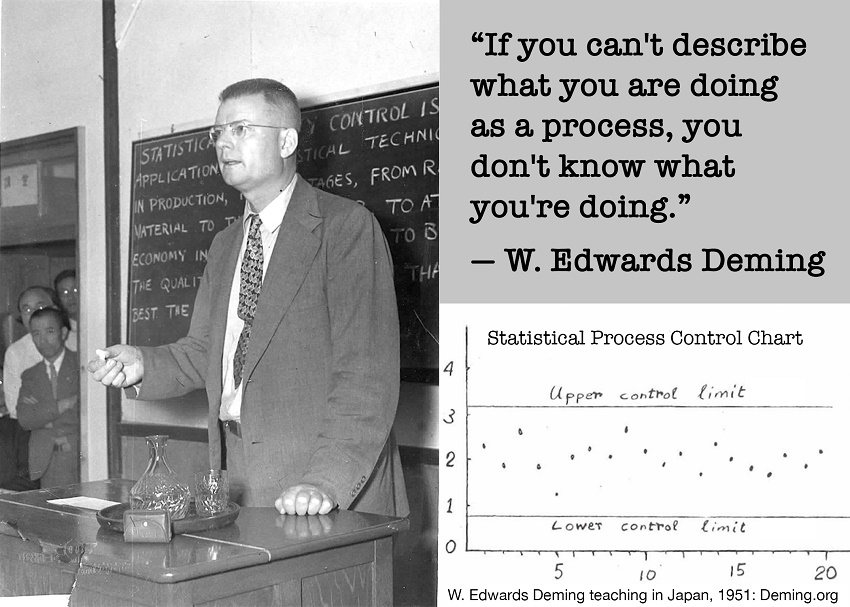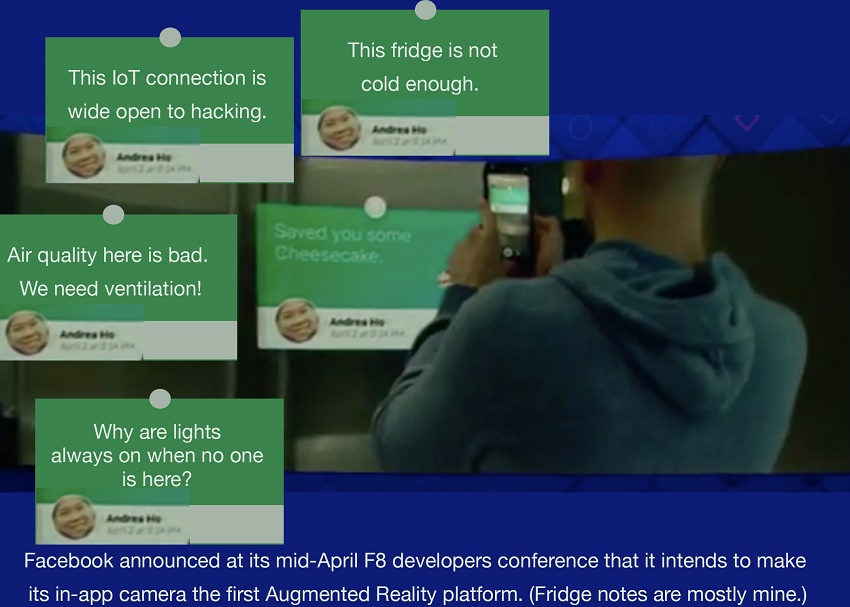Today’s operational analytics, cyber security tools, and other business intelligence software are all ‘grandchildren’ of the statistical process control charts made popular by Deming.

Therese Sullivan,
Principal,
|
May 2017 |
[an error occurred while processing this directive] |
| Operational Analytics, Cyber Security Tools & the Deming Way Today’s operational analytics, cyber security tools, and other business intelligence software are all ‘grandchildren’ of the statistical process control charts made popular by Deming. |
 Therese Sullivan, Principal, |

| Articles |
| Interviews |
| Releases |
| New Products |
| Reviews |
| [an error occurred while processing this directive] |
| Editorial |
| Events |
| Sponsors |
| Site Search |
| Newsletters |
| [an error occurred while processing this directive] |
| Archives |
| Past Issues |
| Home |
| Editors |
| eDucation |
| [an error occurred while processing this directive] |
| Training |
| Links |
| Software |
| Subscribe |
| [an error occurred while processing this directive] |
The
corporate finance types that reason that building analytics projects
need to be justified by energy savings alone need to review the W. Edwards Deming story
in their business school textbooks. Deming’s name is synonymous with
the history of statistical process control — first in post-WW2 Japan,
and then back in the USA in the late 70s once American manufacturing
firms started losing market share to higher quality Japanese products.
Today’s operational analytics, cyber
security tools, and other business intelligence software are all
‘grandchildren’ of the statistical process control charts made popular
by Deming. In the 1950s and ‘60s, Deming’s approach was shunned by US
manufacturers who were more interested in Value-Engineering than
Quality --until Japanese competition gave them a rude awakening.
Value engineering is what is kicking many
building analytics projects off the table today. Decision makers that
would rather stay blind to the ‘slop’ in their buildings’ operational
processes and pay the price of wasted energy are following the same
logic as those pre-Deming American manufacturers that thought they
could live with processes that were creating 3% to 4% defective parts.
At the time, the cost of the materials and manpower that went into the
scrap seemed as easy to ignore as inflated energy spend—a small price
to pay for doing nothing about process control. Of course, now we know
that trying to inspect out bad parts was a fool’s errand. Bad
components infected the supply chain, led to bad products, ruined
customer relationships, tarnished brands, and eventually put companies
out of business.
Deming’s message was that investment in
quality and process control leads to a virtuous cycle of improvement in
products and market competitiveness. Owners might not think of their
buildings as processes that can be brought under control in an
industrial process control sense, but they would do well to brush up on
their Deming because the time is coming when they will be expected to
do just that. Organizations focused on consensus industry standards
like ISA, CSA, and CABA are busy defining what process control of a
building's lifecycle should be. And people have new social-media ways
to make their displeasure known when they are asked to live, work,
learn or heal in an environment with sub-standard temperature control,
lighting, air quality, and secure data.

Facebook announced at its mid-April F8 developer's conference that it intends to make its in-app camera the first Augmented Reality platform. It is not waiting for AR glasses to be perfected. Occupants playing with the ‘fridge notes’ feature could become a facilities manager’s worst nightmare. Or property managers could get ahead of this feature and incorporate this mode of occupant feedback into their workflow processes. In Deming’s day, such an invitation to all stakeholders to participate in process improvement was called a Quality Circle.
Formal process control methodology starts
with having strong and up-to-date industry consensus on the right way
to do things. Events like the CABA Intelligent Buildings & Digital Home Forum
are where leaders gather to discuss current trends and research in
intelligent buildings. I was pleased to be part of this event last week
in Santa Clara, moderating a panel on Cyber Security & Analytics.
There Andre Ristaino, Managing Director of the ISA Automation Standards
Compliance Institute, made the point that cyber security is yet one
more quality dimension that must be controlled in the lifecycle of a
building. He also estimates that commercial buildings are about five to
six years behind other process industries regarding the deployment of
analytics platforms to get operational processes and cyber security
under tight control.
Standards-based product and lifecycle
process certification is the first step toward effective process
control. The ISASecure control systems certification program
strives to certify from the standpoint of the suppliers of commercial
off-the-shelf (COTS) systems, the integrators that combine those
systems into site-specific building control workflows, and the owners
who are responsible for operating and maintaining those assets and
workflows over their lifetime.
The big COTS suppliers of building
equipment are veterans of the quality movement of the last 50 years.
That’s why they are such giant, dominant forces today. For the most
part, their manufacturing processes are six sigma black belt level.
When a COTS supplier deploys cloud-based analytics for remote
monitoring, there is greater confidence that all aspects of the cyber
quality vector have been brought to state-of-the-art levels. For
example, I sat in on the Johnson Controls Smart Connected Chillers webinar
recently. The presenters listed the following as the vital security
factors to look for:
The COTS product level is not what frightens
building owners the most about deploying cloud-hosted analytics. Rather
it is when integrators deploy operational analytics at higher,
whole-building and whole campus levels. First, site-specific
integrators need two-way connectivity to create a feedback loop whereby
analytics results trigger automated adjustments to controls
programming. Still, the cyber security threat can be mitigated. Matt
Jakuc, Product Group Manager and technical lead for the cyber
security program at CSA Group, explained to the CABA Forum audience
that the design engineers and systems integrators responsible for
controls workflow design could be educated in how to do data handling
on par with state-of-the-art IT standards. Also, 3rd-party evaluators
like CSA are available to certify their work. So, fear of hackers
should not derail analytics projects. There is never ‘no risk’ with
Internet connectivity, but the benefit of tapping all the data that
could help get a building’s lifecycle under tight control is worth it.
Regarding that multiplicity of data sources
and all the quality vectors that need to be controlled in addition to
cyber security, this recent quote from Ruairi Barnwell, Energy Services Leader and Principal
of the building design firm DLR Group provides a good list:
“The new Key Performance Indicators (KPI) for building performance in addition to energy use intensity include indoor air quality, thermal comfort of occupants, visual comfort, acoustic comfort and user functionality. Our building owner clients don’t stop at wanting a dashboard for energy; they want visibility into these other factors too.”
Ruairi also
speaks to the challenge of doing data handling on par with
state-of-the-art IT and cyber security standards:
[an error occurred while processing this directive]A spokesperson for one of those building
data management, visualization, and analytics platforms was also on the
CABA Forum Cyber Security &
Analytics panel, Marc Petock of
Lynxspring and Connexx Energy. Marc spoke to the business implications
of ignoring cyber security. He concurred with other panelists that fear
of internet hacking and a focus on energy savings alone when doing
payback calculations are the two factors that have kept the buildings
industry years behind other markets in adopting more sophisticated
data-driven process control. He points out that hard data that
quantifies the degree to which a control system can impact occupant
health, and well-being has been hard to find, to date.
Yet, DLR Group puts it out there: ‘Our goal
is to elevate the human experience of buildings through smart building
design and controls strategies.’ That design firm is breaking down the
challenge into KPIs for its building owner clients, and it is going
about the job of quantifying the ‘fuzzy’ stuff.
It should be noted here that Process
Control guru, W. Edwards Deming never
said: “Only manage, what you can
measure.” The saying “You can only manage, what you can measure,” is
also a misquote. What he said was “It is wrong to suppose that if you
can’t measure it, you can’t manage it – a costly myth.” (Out of the
Crisis, pp 121-126). Perhaps those that argue you should only count
energy savings because that is the only thing you can easily measure
have fallen under the spell of one of the first two misreadings. Deming
is actually encouraging process managers to go further into the
unmeasurable. He continues, “The most important figures that one needs
for management are unknown or unknowable.”
[an error occurred while processing this directive]
[Click Banner To Learn More]
[Home Page] [The Automator] [About] [Subscribe ] [Contact Us]